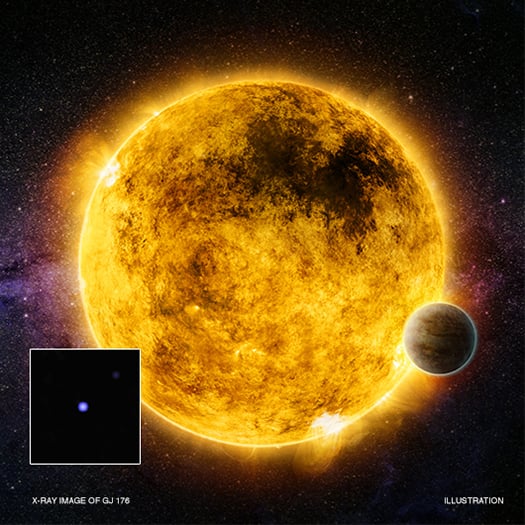Astronomers have long understood that there is a link between a star's magnetic activity and the amount of X-rays it emits. When stars are young, they are magnetically active, due to the fact that they undergo rapid rotation. But over time, the stars lose rotational energy and their magnetic fields weaken. Concurrently, their associated X-ray emissions also begin to drop.
Interestingly, this relationship between a star's magnetic activity and X-ray emissions could be a means for finding potentially-habitable star systems. Hence why an international team led by researchers from Queen's University Belfast conducted
a study
where they cataloged the X-ray activity of 24 Sun-like stars. In so doing, they were able to determine just how hospitable these star systems could be to life.
This study, titled "
An Improved Age-Activity Relationship for Cool Stars Older than a Gigayear
", recently appeared in the
Monthly Notices of the Royal Astronomical Society
. Led by Rachel Booth, a PhD student from the
Astrophysics Research Center at Queen's University Belfast
, the team used data from NASA's
Chandra X-ray Observatory
and the ESA's
XMM-Newton
to examine how the X-ray brightness of 24 Sun-like stars changed over time.
[caption id="attachment_112075" align="aligncenter" width="580"]
This artist's impression shows the magnetar in the very rich and young star cluster Westerlund 1. Credit: ESO/L. Calçada
[/caption]
To understand how stellar magnetic activity (and hence, X-ray activity) changes over time, astronomers require accurate age assessments for many different stars. This has been difficult in the past, but thanks to mission like NASA's
Kepler Space Observatory
and the ESA's
Convection, Rotation and planetary Transits
(CoRoT) mission, new and precise age estimates have become available in recent years.
Using these age estimates, Booth and her colleagues relied on data from the
Chandra X-ray observatory
and the
XMM-Newton
obervatory to examine 24 nearby stars. These stars were all similar in mass to our Sun (a main sequence G-type yellow dwarf star) and at least 1 billion years of age. From this, they determined that there was a clear link between the star's age and their X-ray emissions. As they state in their study:
In short, of the 24 stars in their sample, the team found that 14 had X-ray emissions that were discernible. From these, they were able to calculate the star's ages and determine that there was a relationship between their longevity and luminosity. Ultimately, this demonstrated that stars like our Sun are likely to emit less high-energy radiation as they exceed 1 billion years in age.
And while the reason for this is not entirely clear, astronomers are currently exploring various possible causes. One possibility is that for older stars, the reduction in spin rate happens more quickly than it does for younger stars. Another possibility is that the X-ray brightness declines more quickly for older, more slowly-rotating stars than it does for younger, faster ones.
Regardless of the cause, the relationship between a star's age and its X-ray emissions could provide astronomers and exoplanet hunters with another tool for gauging the possible habitability of a system. Wherever a G-type or K-type star is to be found, knowing the age of the star could help place constraints on the potential habitability of any planets that orbit it.
 Universe Today
Universe Today
